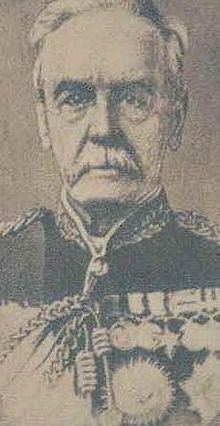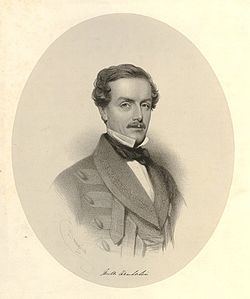Allegiance United Kingdom Name Neville Chamberlain | Years of service 1837–1886 Role Armed force officer | |
 | ||
Battles/wars First Anglo-Afghan WarGwalior CampaignSecond Anglo-Sikh WarIndian RebellionSecond Anglo-Afghan War Spouse Charlotte Curler (m. 1873) Parents Anna Eugenia Morgan, Sir Henry Chamberlain, 2nd Baronet Siblings Crawford Chamberlain, William Charles Chamberlain, Charles Francis Falcon Chamberlain Grandparents Sir Henry Chamberlain, 1st Baronet Nephews Houston Stewart Chamberlain | ||
Service/branch British Indian Army | ||
Field Marshal Sir Neville Bowles Chamberlain (10 January 1820 – 18 February 1902) was a senior Indian Army officer. He fought at the Battle of Ghazni in July 1839 during the First Anglo-Afghan War, the Battle of Maharajpur in December 1843 during the Gwalior Campaign and the Battle of Chillianwala in January 1849 and the Battle of Gujrat in February 1849 during the Second Anglo-Sikh War. During the Indian Rebellion he served as Adjutant-General of the Indian Army and was severely wounded at the Siege of Delhi in July 1857. He went on to be Commander-in-chief of the Madras Army in February 1876 and was sent on a mission to the Emir of Afghanistan, Sher Ali Khan, whose refusal to allow him to enter the country precipitated the Second Anglo-Afghan War in November 1878.
Contents

Military career

Chamberlain was born the third son of Sir Henry Chamberlain, 1st Baronet, consul general and charge d'affaires in Brazil, and his second wife Anna Eugenia née Morgan. His elder brother, William Charles Chamberlain, was an admiral, while younger brothers Crawford Chamberlain, and Charles Francis Falcon Chamberlain, were also army officers.
Chamberlain initially entered the Royal Military Academy, Woolwich but was withdrawn after a year and was commissioned as an ensign in the Bengal Native Infantry on 24 February 1837. He fought at the Battle of Ghazni in July 1839 as well as other engagements during the First Anglo-Afghan War and was wounded on several occasions. Promoted to lieutenant on 16 July 1842, he transferred to the 1st Cavalry of Shah Shujah's Contingent and took part in a march from Kandahar to Kabul in August 1842. During the withdrawal from Kabul he was again wounded at Landi Kotal in October 1842 and again at Ali Masjid in November 1842. He became attached to the Governor-General's Bodyguard in January 1843 and took part in the Battle of Maharajpur in December 1843 during the Gwalior Campaign.
Chamberlain became military secretary to the Governor of Bombay in late 1846 and then brigade major with the Bengal Irregular Cavalry in 1848. He took part in the Battle of Chillianwala in January 1849 and the Battle of Gujrat in February 1849 during the Second Anglo-Sikh War. He became assistant adjutant-general of the Sirhind division in May 1849 and, having been promoted to captain in the 16th Bengal Native Infantry on 1 November 1849 and to brevet major on 2 November 1849, he became assistant commissioner in the Rawalpindi District in December 1849 and then assistant commissioner in the Hazara District in June 1850. Promoted to lieutenant-colonel on 28 November 1854, he was given the command of the Punjab Irregular Frontier Force and led several expeditions against the frontier tribes. During the Indian Rebellion he served as Adjutant-General of the Indian Army and was severely wounded at the Siege of Delhi in July 1857. For this he was appointed a Companion of the Order of the Bath on 11 November 1857 and promoted to colonel on 27 November 1857.
Chamberlain was reappointed to the command of the Punjab Irregular Frontier Force in 1858 and led it during the Ambela Campaign during which he was again severely wounded again in November 1863. Advanced to Knight Commander of the Order of the Bath on 11 April 1863, he returned to the United Kingdom and was promoted to major-general for distinguished service on 5 August 1864. He was appointed a Knight Commander of the Order of the Star of India on 24 May 1866 and accompanied the Duke of Edinburgh on an official trip to India in 1869. He was promoted to lieutenant-general on 1 May 1872, advanced to Knight Grand Commander of the Order of the Star of India on 24 May 1873 and further advanced to Knight Grand Cross of the Order of the Bath on 28 May 1875.
Chamberlain became Commander-in-chief of the Madras Army in February 1876 and, having been promoted to full general on 1 October 1877, was sent on a mission to the Emir of Afghanistan, Sher Ali Khan, whose refusal to allow him to enter the country precipitated the Second Anglo-Afghan War in November 1878. He was a member of the Madras Legislative Council and, for several months, acting military member of the council of the Governor-General of India. He left India in February 1881 and retired to Lordswood near Southampton in February 1886.
In retirement Chamberlain was an active member of the Southampton Unitarian Church. He was promoted to field marshal on 25 April 1900, died at Lordswood on the 18 February 1902 and was buried at Rownhams near Southampton.
Family
In 1873 Chamberlain married Charlotte Cuyler Reid, daughter of Major-General Sir William Reid, who died in 1896; there were no children.
